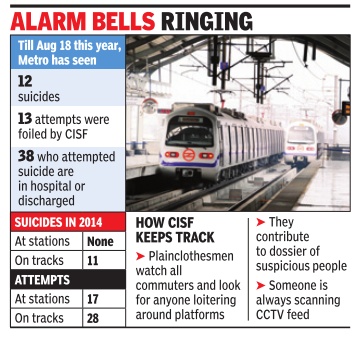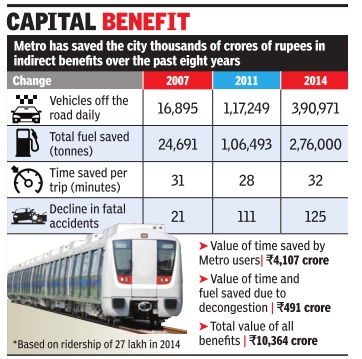Delhi: Metro rail
(→Economic benefits: 2007-2012) |
|||
| Line 1: | Line 1: | ||
| + | [[File: Suicides and attempts, 2014, Jan-Aug 2015.jpg|Suicides and attempts: 2014, Jan-Aug 2015; Graphic courtesy: [http://epaperbeta.timesofindia.com/Gallery.aspx?id=23_08_2015_003_021_010&type=P&artUrl=Metro-stations-turn-suicide-zones-23082015003021&eid=31808 ''The Times of India''], August 22, 2015|frame|500px]] | ||
| + | |||
| + | |||
{| class="wikitable" | {| class="wikitable" | ||
Revision as of 14:07, 23 August 2015

This is a collection of articles archived for the excellence of their content. |
Ranked 2nd among 18 international metro systems
Delhi Metro ranked 2nd among 18 international metro systems
PTI | Sep 28, 2014
NEW DELHI: Delhi Metro has been ranked second among 18 international Metro systems in terms of overall customer satisfaction in an online customer survey.
According to a DMRC official, in the survey conducted among the commuters of those Metro systems by Global Metro Benchmarking Groups 'NOVA' and 'CoMET', Delhi Metro along with London DLR and Bangkok were the best three performers in the 'Net Promoters Score' (NPS) category.
Under this category the survey analysed the likelihood of customers recommending the service to others on the basis of their satisfaction.
More than 41,000 respondents gave their feedback worldwide in this survey conducted online through the websites and social media links of 18 major Metros of the world from April 28th to May 25th earlier this year. The Metro systems that participated in this survey apart from Delhi Metro were Hong Kong MTR, London Underground, Metro De Madrid, Paris RATP, Metro De Sandiago, Singapore SMRT, Barcelona TMB, Brussels STIB, Bangkok BMCL, London DLR, Istanbul Ulasim, Kualalumpur Rapid PL, Metropolitano De Lisboa, Montreal STM, Newcastle Nexus, Metro Rio and Toronto TTC.
The NPS is calculated by the percentage of promoters minus the percentage of detractors (P-D = NPS).
When asked to list out the three top priority areas, the respondents from Delhi along with 17 other Metros listed as 'availability' as the most important requirement. Only New Castle and Hong Kong selected 'Reliability' as their most important area.
"Delhi Metro commuters rated reliability and crowding as the other two important priority areas," the official said.
The survey was conducted as per the 'European Norm 13816' and the areas covered were availability, accessibility, ease of use, information prior to travel, information during travel, reliability, customer care, comfort, crowding, and security.
DMRC is a member of the NOVA group of Metros which is a benchmarking community comprising of 17 metro systems (small and medium size metros) from around the world.
It provides a platform to share experiences, ideas and good practices followed by member Metro systems across the world. It also helps in evaluating the performance of Metro systems by studying their key performance indicators. The forum is co-ordinated by the Rail Transport Strategic Centre (RTSC) of Imperial College, London.
This year, DMRC hosted the NOVA Phase-17 Management Meeting in New Delhi from September 24-26. The meeting was attended by 11 NOVA member Metros including DMRC and two Indian observers' Metros (Bangalore Metro and Chennai Metro).
DMRC will be elevated to CoMET (Community of Metros) Group of Metros. The CoMET is a group of 16 of the world's largest Metros. To qualify for becoming a member of CoMET, the average ridership should be above 20 lakh and the city should be the primary city of country.
Economic benefits: 2007-2012
Dec 25 2014
Delhi Metro rides high and is keeping 3.9 lakh vehicles off roads
The Delhi Metro Rail Corporation (DMRC), that celebrated 12 years of its operation claimed to have kept nearly 3.9 lakh vehicles off roads in 2014.The head of DMRC, Mangu Singh, said the Metro helped save Rs 10,364 crore in fuel, time saved in commuting and other benefits. It also helped reduce air pollution and accidents. The figures, revised and calculated by Central Road Research Institute (CRRI), quantify the benefits of the 190kmlong Delhi Metro network. The numbers are certainly eyeopener. According to CRRI, the Metro also saved 32 minutes on every trip taken by a commuter. This is a jump from the 28 minutes saved in 2011.
Delhi Metro saved Rs 1,972 crore in fuel conserved. In absolute terms, it saved 2.7 lakh tonnes of fuel in 2014 as against 1.06 lakh tonnes in 2011. The savings in cost of vehicle capital and operation was Rs 2,617 crore while indi vidually, Delhi Metro commuters saved Rs 4,107 crore in terms of money from time saved.
That's not all. The Delhi Metro also impacted the accident figures in the city. The annual reduction in fatal accidents was 125 in 2014 as against 111 and 21 in 2011 and 2007 respectively when Phase II of the network was constructed. The annual reduction in terms of accidents per se was 937 in 2014 as against 591 and 93 in 2011 and 2007 respectively .
The amount from time and fuel saved due to decongestion resulting from Delhi Metro is Rs 491 crore. Savings from reduction in pollution due to Metro was Rs 489 crore. In fact, the total savings from all the benefits is Rs 10, 364 crore in 2014. All the figures are based on a daily ridership of 27 lakh.
DMRC also introduced a number of features this year.Besides the opening of two stations Janpath and Mandi House -the Delhi Metro also converted 11 trains into eightcoach trains, maintained an average punctuality percentage of 99.88% and increased the ridership by over 20,000 passengers from last year.
